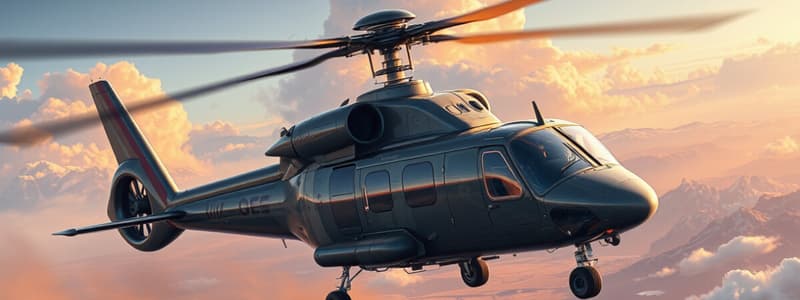Podcast
Questions and Answers
What is the primary advantage of using a turbine engine in helicopters?
What is the primary advantage of using a turbine engine in helicopters?
- Less expensive to operate than piston engines
- Simplified maintenance requirements
- More powerful for their size (correct)
- Better cooling efficiency
Which type of rotor system allows for the most range of movement of the blades relative to the hub?
Which type of rotor system allows for the most range of movement of the blades relative to the hub?
- Semi-rigid
- Fully articulated (correct)
- Fixed
- Rigid
How do pilots maintain directional control of a helicopter during changes in main rotor torque?
How do pilots maintain directional control of a helicopter during changes in main rotor torque?
- By varying the thrust of the antitorque system (correct)
- By increasing rotor speed
- By altering fuel flow to the engines
- By adjusting the blade pitch
What does the Fenestron system contribute to a helicopter?
What does the Fenestron system contribute to a helicopter?
Which description accurately defines the exhaust outlets of turbine engines in helicopters?
Which description accurately defines the exhaust outlets of turbine engines in helicopters?
Which helicopter type is characterized by having two main rotors that rotate in opposite directions?
Which helicopter type is characterized by having two main rotors that rotate in opposite directions?
Which type of helicopter eliminates the need for a tail rotor by using rotors mounted on the same axis?
Which type of helicopter eliminates the need for a tail rotor by using rotors mounted on the same axis?
What was the main drawback of the helicopter engineered by Louis Breguet in 1907?
What was the main drawback of the helicopter engineered by Louis Breguet in 1907?
Which type of helicopter uses additional propulsion systems to achieve higher speeds?
Which type of helicopter uses additional propulsion systems to achieve higher speeds?
Which of the following statements about the history of helicopters is correct?
Which of the following statements about the history of helicopters is correct?
Flashcards
Leonardo da Vinci's Helix
Leonardo da Vinci's Helix
Da Vinci's concept of a 'helix' in the 1500s that contributed to helicopter design.
Single-Rotor Helicopter
Single-Rotor Helicopter
A helicopter featuring one main rotor for lift and a tail rotor to counteract torque.
Tandem Rotor Helicopters
Tandem Rotor Helicopters
Helicopters with two rotors aligned front-to-back, rotating in opposite directions to provide lift and stability.
Rigid Rotor Systems
Rigid Rotor Systems
Signup and view all the flashcards
Semi-Rigid Rotor Systems
Semi-Rigid Rotor Systems
Signup and view all the flashcards
Fully Articulated Systems
Fully Articulated Systems
Signup and view all the flashcards
Reciprocating Engines
Reciprocating Engines
Signup and view all the flashcards
Fenestron (Fan-in-Tail)
Fenestron (Fan-in-Tail)
Signup and view all the flashcards
Flapping (Rotor Blades)
Flapping (Rotor Blades)
Signup and view all the flashcards
Collective Control
Collective Control
Signup and view all the flashcards
Study Notes
Historical Development of Helicopters
- Leonardo da Vinci conceptualized the "helix" in 1500, laying groundwork for helicopter design.
- Early 1800s saw the construction of small flying helicopter models.
- In 1907, Louis Breguet created a man-carrying helicopter that achieved flight but was unstable.
- The U.S. Army initiated helicopter projects post-1921, contracting Dr. George de Bothezat.
- A significant four-rotor helicopter from the U.S. Army flew in 1922.
Types of Helicopters
- Single-Rotor Helicopters: Feature one main rotor for lift and a tail rotor for counteracting torque.
- Tandem Rotor Helicopters: Have two rotors aligned front-to-back that rotate in opposite directions.
- Coaxial Rotor Helicopters: Employ two rotors on the same axis, eliminating the need for a tail rotor.
- Compound Helicopters: Include additional propulsion methods (e.g., jets) for increased speed.
Helicopter Rotor Systems
- Main rotor systems categorized by blade attachment and movement: Rigid, Semi-rigid, Fully articulated.
- Rigid systems: Blades cannot flap or lead-lag, known for simplicity and efficiency.
- Semi-rigid systems: Comprised of two rigidly attached blades allowing the hub to tilt.
- Fully articulated systems: Each blade can independently flap, lead-lag, and feather, providing versatility.
Engine and Powerplant
- Helicopters typically use reciprocating engines for smaller models due to their simplicity and low cost.
- Turbine engines offer more power and are used in various helicopters, albeit at a greater operational cost.
- Exhaust systems primarily expel gases without aiding in forward propulsion, differing from jet engines.
Tail Rotor Systems
- The tail rotor uses anti-torque thrust to maintain control as main rotor torque changes.
- A Fenestron (fan-in-tail) design features blades within a duct, increasing safety and control.
Transmission System
- Transfers power from the engine to main components, including the main rotor and tail rotor.
- The swash plate assembly translates rotor movements; consists of upper and lower plates for dynamic pitch control.
Rotor Blade Movements
- Main rotor blades exhibit multiple movements: Flap (vertical movement), Lead-Lag (fore/aft movement), Feathering (changing pitch angle).
- Flapping allows for coordinated vertical movement of blades; lead-lag contributes to rotor stability.
Flight Controls
- Collective control alters all rotor blades’ pitch simultaneously, impacting lift.
- Cyclic control changes blade pitch during rotation to direct flight.
- Foot pedals manage the tail rotor blade pitch, balancing rotor torque.
- Throttle maintains engine power for rotor operation and overall lift capability.
Studying That Suits You
Use AI to generate personalized quizzes and flashcards to suit your learning preferences.



